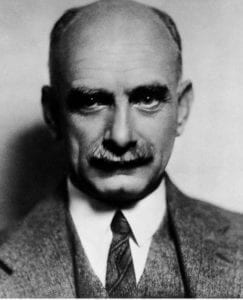
In republishing an account of clinical electrocardiography, I do so from conviction that this method of examination is essential to the modern study of heart disease. When some twenty-seven years ago I began to study disorders of the heart with the aid of the “string galvanometer” the method was in its early infancy and unknown in this country; although it was regarded at that time as full of promise, yet the scope, in helping to perfect knowledge of heart disease, could not then be foreseen. Electrocardiography has taken us far, having filled great gaps in our knowledge of these maladies; for it is a means of directly examining the all-essential heart muscle.
— Sir Thomas Lewis, preface to Clinical Electrocardiography, published by Shaw and Sons Ltd, London, 1937
Sir Thomas Lewis (1881-1945) is regarded as the “father of clinical cardiac electrophysiology.” As a young man he began studying diseases of the heart using the polygraph, a device invented by his chief Sir James Mackenzie to record the pulses in the carotid, jugular, and femoral vessels. Hearing of the work of the Dutch physiologist Willem Einthoven, who had shown that the heart generated electrical activity and had been able to measure it, he acquired one of the EKG machines made in his laboratory. Later he had his own devices made in England. In 1908 he began to use it on patients in the wards of University College Hospital. Over the years he studied the various abnormalities of cardiac rhythm such as heart block and atrial fibrillation, the mechanisms of their production, and their clinical features. His book Clinical Electrocardiography, first published in 1913, was the first ever publication on that subject.
In his time Thomas Lewis was the most eminent cardiologist in Britain. Born and initially educated in Wales, he went to London to study medicine at University College Hospital. By the time he graduated in 1906 he had already published a paper on the spleen and lymph nodes. But his research career was shaped by his contact with eminent physiologists such as Ernest Starling and Arthur Cushny, and by his distinguished chief, Sir James Mackenzie, who had established a cardiac research unit at University College Hospital, where he remained all his life. He worked on arrhythmias, coronary heart disease, and heart failure. During World War I he studied the so-called soldier’s heart or effort syndrome on behalf of the government. After the war he switched his interests to the response of skin blood vessels to injury, postulating the release of a histamine like product that he called substance H; and later to peripheral vascular disease and the mechanism of ischemic and, pain, postulating the release of a factor P.
As a chief, Lewis was described as being demanding, severe, expecting high standards of performance from his subordinates, a tough editor, a man of few words, and not very sociable. His hobbies were photography and birds. He gave up chain-smoking after his first coronary heart attack when he was 45 and at that stage became convinced that smoking was harmful to the heart. After his third myocardial infarction he developed heart failure and died in 1945 at the age of 64.
Sir Thomas Lewis furthered the development of American cardiology by having Paul Dudley White, Samuel Levine, and other young American physicians work with him. One of his pupils became prime minister of Mauritius and commemorated the hundredth anniversary of his birth by issuing an expensive stamp. It shows a man with a bottlebrush mustache and an intense gaze, and his 1908 prototype of a piece of equipment that to this day continues to be used in every country of the world.
References
- Cygankiewicz I, Sir Thomas Lewis. Cardiology Journal. 2007; 14:605.
- Davies MK, Hollman A. Sir Thomas Lewis. Heart 1996; 76:383.
- Pickering, G.W.: Thomas Lewis, obituary, Lancet 1945;1:419.

Leave a Reply